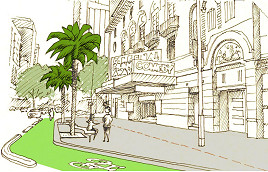Dining in style at Spencer Street Station
By Dr Cheryl Griffin
Spencer Street Station (now Southern Cross Station) has been the first port of call for country and interstate train travellers since the 1850s.
In the 1920s, when this photograph was taken, it more or less represented the western edge of the CBD. Collins St and Bourke St ended at Spencer St and goods sheds and industrial buildings dominated the landscape. Redeveloped in the 1920s, it was extended to introduce suburban trains, but to generations of Victorians it was known as the point of arrival and departure for those on long-distance journeys. Today, there are bus terminals and Skybuses and much more to add to the busyness of the station, but until the 1950s when car and air travel began to take over, it resonated with the sound of steam trains arriving and departing.
When historian Graeme Davison wrote of Spencer Street’s “Hollywood heyday” in the Royal Historical Society’s 2016 publication Remembering Melbourne, he didn’t have the Spencer Street Railway Station’s Refreshment Rooms in mind. He was thinking of the grand hotels that cropped up around what was Melbourne’s largest transport interchange. And of the celebrities who arrived and departed with great fanfare. Yet you can see suggestions of the glamour of Hollywood in this 1920s photograph of a VR staff member standing beside his refreshment trolley on a station platform.
There is nothing utilitarian about the presentation of the refreshments on offer here. The urns (presumably of tea and coffee) are elaborately decorated. No takeaways in those days, of course, so the crockery, cutlery and glasses were no doubt spirited away to be washed up ready for use again later in the day. The station’s Refreshment Rooms held a wine licence, so as well as hot beverages, you can see a number of bottles of what appears to be champagne and maybe even a decanter of spirits.
The “light refreshments” on offer include healthy options like fresh fruit, featured prominently on the top tray – apples, possibly from the orchards at Harcourt, on the Bendigo line. There are sandwiches, not pre-packaged as we expect today, but pre-cut and piled high on trays behind glass on the bottom level. I can imagine how dried up they’d be if they weren’t sold soon after making and I can only wonder at the fillings that were used. My mind goes to fish paste, a favourite of my mother’s (she didn’t have any competition!). Kraft cheese was introduced to Australia in the 1920s, so perhaps VR catering extended to the latest amazing import from the US. And then there’s the iconic Vegemite, launched in 1923 and the favourite of generations of “Happy Little Vegemites”. There were the sweet treats, too – scones, I think, and cakes. Advertising of the time tells us that one of the healthy drinks on offer was pasteurised milk, promoted as a “perfect food” and only threepence a glass (about $1 in today’s buying power). And then there was the inevitable confectionery and the ubiquitous tobacco, cigars and cigarettes. Nothing healthy about those, but an accepted part of life in those days.
The Refreshment Rooms themselves were immensely popular and open week days from 6am to 7pm. On Saturdays they opened from 11am to 3pm. (Remember that these were the days when shops closed at Saturday lunchtime and sport was king on Saturday afternoons). They were closed on Sunday, which was church and family day. It was not until the early 1990s that stores in the CBD were allowed to trade on Sundays.
Newspapers of the day tell us that in 1924 the Refreshment Rooms served 1600 meals each day and could take 120 customers per sitting. There were 60 waitresses on the staff (no men, except on the platforms or on the trains) and there was even a nearby hostel where the waitresses could live.
The rooms boasted that they provided the best meal in Melbourne for the money – a three course meal for only 1/3d (about $5 in today’s buying power). The price was the biggest drawcard, I think, but I’ll leave that for you to decide. Here’s a sample menu: soup – gravy soup or beef tea. Entrée - steak and kidney pudding, stewed rabbit, baked pork and Boston beans. Joint – hot: roast sirloin of beef, roast leg of mutton, and savoury dressing. Or cold: roast beef, roast mutton, corned beef. Sweets - ginger pudding, lemon cream, compote fruit and rice. Served with a cup of tea, coffee or cocoa •

Council endorses office tower at Flinders Lane despite querying car park demolition






 Download the Latest Edition
Download the Latest Edition